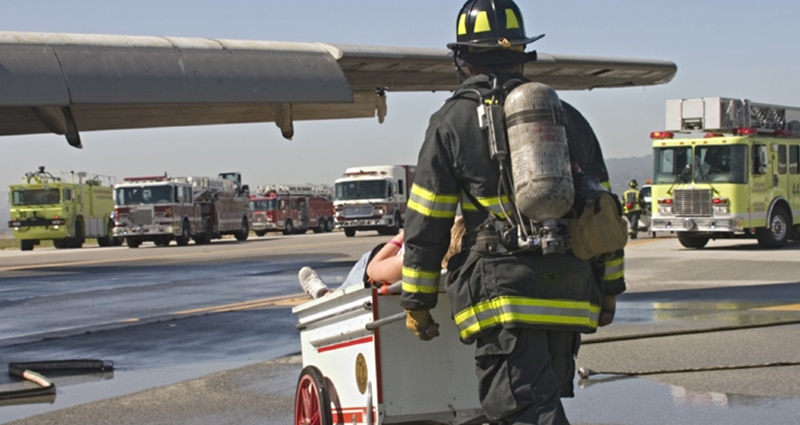NIMS Resource Management

Welcome back to our continuing discussion of the National Incident Management System (NIMS). We first introduced you to NIMS in the fourth quarter newsletter of 2011. Subsequent NIMS articles appeared in the first and second quarters of 2012. As a recap, NIMS addresses five basic response components:
- Preparedness
- Communications and Information Management
- Resource Management
- Command
- Ongoing Management and Maintenance
Successful response and mitigation involves getting the right resources to the right place at the right time. To facilitate this process, responders must complete a series of activities before, during, and after an incident to achieve success.
In this issue of the newsletter, we’ll discuss Resource Management, which begins in the planning phase while writing your Aeronautical Emergency Operations Plan (AEOP). While developing your AEOP, you should consider what might happen, how likely it is to happen, how disastrous it may be, and how many people might be affected.
Once you have identified your risks and potential consequences, you can project your resource needs. NIMS identifies seven general groups of resources:
- Personnel: Determine the number of people and the type of skill sets you will need to respond to the incident, staff the Emergency Operations Center (EOC), and notify emergency contacts.
- Facilities: Identify where the EOC will be located. Specifically, determine the additional office space you’ll need based on personnel and tasks. If you need warehouse space, ensure your plan identifies a location(s) with access available 24 hours/day.
- Equipment: Identify any communications equipment required to work individually and as a team, and any requirements to maintain your response records and files. Maybe you’ll need to move debris; identify the equipment and operators required to complete this task.
- Vehicles: For some events, you will need buses, vans or cars to transport people or equipment.
- Teams: You may require groups of specialized people to perform specific tasks such as notifying emergency contacts, serving as care team members, or providing mechanical help. Identifying training needs and proactively scheduling ongoing training will ensure your team is prepared if an incident occurs.
- Aircraft: Aircraft can be used for surveillance, MedEvac, cargo or personnel transport.
- Supplies: This includes everything from drinking water to computer paper.
The next step in the process is to identify potential sources for the resources you require. If you can meet resource needs internally, make sure they have been tested through drills and exercises. If shortfalls are found during an exercise or drill, document them in the after action report and implement an action plan to correct any deficiencies. If you can’t meet resource needs internally, external resources are available to fill any gaps while ensuring your organizational priorities are maintained.
Consider any equipment or supplies you have that may be useful in the event you respond to an incident. Equipment and supplies can be stockpiled (be aware of shelf life on certain items) for emergencies. Pre-incident, just-in-time contracts with vendors can also be developed to provide a guaranteed delivery of specific resources in the right quantity and quality. You can avoid price gouging by ensuring contracts establish the cost of services or supplies based on prices the day before the incident happens.
In your AEOP, establish how self responders or “donations” will be addressed, and pre-establish guidelines on acceptable goods and services. For example, if you accept food from a non-profit organization, will the health department be required to inspect the food service preparation areas? If so, you may want to accept only pre-inspected or pre-packaged food items. Also, make sure plans have protocols to ensure personnel accountability and safety for volunteers. Check the company’s liability insurance policy to determine if volunteers are covered and if coverage is adequate.
The next step in the resource management process is to ensure your plans include specific action items required for implementation. A detailed list of roles and responsibilities with 24-hour contact information and a corresponding action-oriented checklists will also be helpful. Be sure to include personnel with purchase authority and financial controls who can fulfill the incident’s resource needs.
Specific systems and protocols to prioritize resources should also be addressed. Collect data on all resources ordered, dispatched, and delivered; and document location and times of usage, and the return to normal status. Keep in mind that personnel or equipment costs, and liability are calculated from the time of dispatch to the time of return to their parent organization. Include a process to debrief and re-integrate personnel back to “normal” operations, re-stock your “go bags” and/or pay for the goods or services rendered by outside providers.
Finally, in preparation for your resource management needs, prepare a complete inventory of all your resources. Create a “yellow pages” directory that is categorized by resource type, resource location, acquisition details, and any procurement procedures. Maintain your “yellow pages” in various formats and in different locations for easy access and redundancy, and update regularly to maintain accuracy.
According to NIMS, the person in charge of the incident, or the Incident Commander (IC), will size up the current and potential situation. The IC’s assessment will define the incident objectives based upon the “LIPP” concept.
Life Safety
Incident Stabilization
People Protection and Care
Property / Environmental Conservation
Once the IC determines the incident objectives, he/she can develop strategies and tactics to identify the resources required to complete the next and upcoming incident action. The party responsible for procuring resources can then initiate the ordering process. For first responders, this may be ordering additional fire apparatus and scene security staff. For your organization, it may involve calling the EOC and notification staff to their trained positions and instituting the “call home” policy.
In summary, identifying your resource needs and developing specific plans and procedures to acquire those resources is an important part of your AEOP. Training and exercising your AEOP procurement procedures with your emergency responders, organizational partners and contractors will aid in the primary objective of resource management: getting the right resources, to the right place, at the right time.
For more information:
http://www.fema.gov/resource-management
 Fireside Partners, LLC
Fireside Partners, LLCAn international leader in Corporate Emergency Response Plan (ERP) development, Crisis mitigation and organizational training and assessment for appropriate response.
http://www.firesideteam.com/
© 2024 Fireside Partners, LLC. All Rights Reserved.
Next ArticleRelated Posts

Safety in Numbers: Trends in Aviation Accidents and Incidents
Every accident is preventable; the problem is that we don’t know how to prevent it until after the accident happens. However, what we can do as an industry is honor the anguish of each event by sharing the information, the mistakes and the outcomes to improve safety for everyone.

Is ChatGPT Ready To Analyze My SMS Portal’s Safety Reports?
While industry experts continue to design the next-gen AI-backed SMS software solution, safety managers can use ChatGPT to help them treat safety issues, audit findings and classify hazards contained in their SMS reporting.

